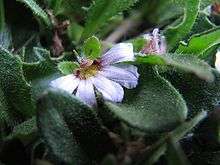Scaevola hookeri
| Scaevola hookeri | |
|---|---|
 | |
| Scientific classification | |
| Kingdom: | Plantae |
| (unranked): | Angiosperms |
| (unranked): | Eudicots |
| (unranked): | Asterids |
| Order: | Asterales |
| Family: | Goodeniaceae |
| Genus: | Scaevola |
| Species: | S. hookeri |
| Binomial name | |
| Scaevola hookeri (de Vriese) F.Muell. ex Hook.f. [1] | |
| Synonyms | |
| |
Scaevola hookeri, the creeping fan-flower or alpine fan-flower, is a prostrate perennial herb in the family Goodeniaceae. It is native to eastern Australia. Leaves are 6 to 50 mm long and 2 to 15 mm wide. Flowers are white or blue with a yellowish throat and appear between December and March in the species native range.[2] The species was first formally described by W.H. de Vriese in 1850 in Nederlandsch Kruidkundig Archief and given the name Merkusia hookeri. The species was transferred to the genus Scaevola in 1856. It occurs in grassland and woodland in high altitude areas in Victoria, New South Wales, Tasmania, and also South Australia where it is listed as "endangered".[2][3]
References
- ↑ "Scaevola hookeri". Australian Plant Name Index (APNI), IBIS database. Centre for Plant Biodiversity Research, Australian Government.
- 1 2 "Scaevola hookeri". PlantNET - New South Wales Flora Online. Royal Botanic Gardens & Domain Trust, Sydney Australia. Retrieved 2010-01-02.
- ↑ "Census of South Australian Vascular Plants Edition 5.00" (PDF). Botanic Gardens of Adelaide & State Herbarium. 2005.
This article is issued from Wikipedia - version of the 5/1/2016. The text is available under the Creative Commons Attribution/Share Alike but additional terms may apply for the media files.